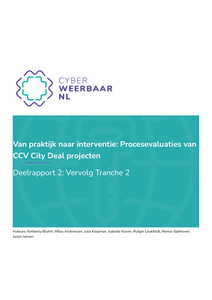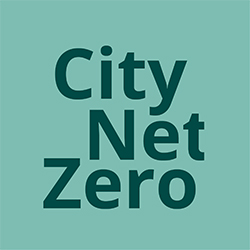This open access book presents a selection of the best contributions to the Digital Cities 9 Workshop held in Limerick in 2015, combining a number of the latest academic insights into new collaborative modes of city making that are firmly rooted in empirical findings about the actual practices of citizens, designers and policy makers. It explores the affordances of new media technologies for empowering citizens in the process of city making, relating examples of bottom-up or participatory practices to reflections about the changing roles of professional practitioners in the processes, as well as issues of governance and institutional policymaking.
DOCUMENT

Municipalities often collaborate with other stakeholders in smart city projects to develop and implement technological innovations to address complex urban issues. We propose the shared portfolio approach as an alternative way of collaborating, because we have identified possible limitations when the commonly used single-project approach is adopted in complex contexts, such as the smart city context. The portfolio approach enhances flexibility, an embedded focus and cross-project learning, because partners work on multiple projects – either in parallel or in succession – to develop multiple solutions to a specific problem. An in-depth case study is used to illustrate how the shared portfolio approach works. In practice, these insights can be used by public bodies who aim to collaborate in smart city development or by partners who work on smart city projects and wish to continue their collaboration in a portfolio setting. Conceptually, our paper develops a connection between cross-sector partnership literature and smart city literature by revealing how the shared portfolio approach could be an effective way to deal with the complexities of innovation in the smart city context.
DOCUMENT

Dit rapport bevat de resultaten van de tweede ronde procesevaluaties van zes cyberweerbaarheidsprojecten binnen de City Deal Lokale Weerbaarheid Cybercrime. De evaluaties zijn uitgevoerd door onderzoekers van meerdere hogescholen en richten zich op hoe lokale en regionale initiatieven werken aan het versterken van cyberweerbaarheid onder burgers, bedrijven en overheden. Het doel van het rapport is om inzicht te geven in: de voortgang van de projecten; succesfactoren en belemmeringen; lessen voor toekomstige (samenwerkings)projecten op het gebied van cyberweerbaarheid.
DOCUMENT

Renewable energy, particularly offshore wind turbines, plays a crucial role in the Netherlands' and EU energy-transition-strategies under the EU Green Deal. The Dutch government aims to establish 75GW offshore wind capacity by 2050. However, the sector faces human and technological challenges, including a shortage of maintenance personnel, limited operational windows due to weather, and complex, costly logistics with minimal error tolerance. Cutting-edge robotic technologies, especially intelligent drones, offer solutions to these challenges. Smaller drones have gained prominence through applications identifying, detecting, or applying tools to various issues. Interest is growing in collaborative drones with high adaptability, safety, and cost-effectiveness. The central practical question from network partners and other stakeholders is: “How can we deploy multiple cooperative drones for maintenance of wind turbines, enhancing productivity and supporting a viable business model for related services?” This is reflected in the main research question: "Which drone technologies need to be developed to enable collaborative maintenance of offshore wind turbines using multiple smaller drones, and how can an innovative business model be established for these services? In collaboration with public and private partners, Saxion, Hanze, and RUG will research the development of these collaborative drones and investigate the technology’s potential. The research follows a Design Science Research methodology, emphasizing solution-oriented applied research, iterative development, and rigorous evaluation. Key technological building blocks to be developed: • Morphing drones, • Intelligent mechatronic tools, • Learning-based adaptive interaction controllers and collaborations. To facilitate the sustainable industrial uptake of the developed technologies, appropriate sustainable business models for these technologies and services will be explored. The project will benefit partners by enhancing their operations and business. It will contribute to renewing higher professional education and may lead to the creation of spin-offs/spinouts which bring this innovative technology to the society, reinforcing the Netherlands' position as a leading knowledge economy.
Een vraagarticulatieproces met projectmanagers en -leiders uit private en Triple-Helix organisaties laat zien dat zij behoefte hebben aan tools voor: 1. Het bepalen van de juiste incentives om stakeholders actief te betrekken in multi-sector collaboratieve innovatieprojecten (verder verwezen als innovatieprojecten), en 2. Het concreet, transparant en op één lijn te krijgen van de belangen van de partners. Vandaar dat dit project betreft het doorontwikkelen van het Degrees of Engagement diagram (DoE-diagram), een tool voor het managen van stakeholder engagement in innovatieprojecten voor het behalen van de maatschappelijke opgaven. Hiermee sluit het project aan bij de programmalijn ‘rollen, belangen en coördinatie’ van de Kennis en Innovatieagenda van de missie Maatschappelijke Verdienvermogen- thema’s Klimaat & Energie en Circulaire economie. Het consortium bestaat uit de Hogeschool van Amsterdam (HvA), KplusV en Amsterdam Smart City (ASC). De HvA ontwikkelde het DoE-diagram. Voor het identificeren van stakeholders bevat het DoE-diagram attributen op project- en organisatieniveau. In dit project wordt het DoE doorontwikkeld door onderzoek te doen naar: 1. De attributen op individuniveau en potentiele nieuwe attributen op project- en organisatieniveau, 2. De mate waarin deze attributen invloed hebben op het bepalen van de passende incentives, de concretisering van de partnerbelangen en al dan niet succesvolle verloop van innovatieprojecten, 3. Een verkenning van een digitale versie van het DoE voor het managen van in- en uitstappen van partners. Hiermee beoogt het project twee doelen: 1. Inzicht verkrijgen in stakeholderconfiguraties voor het ondersteunen van beslissingen met betrekking tot stakeholder-engagement, 2. Bouwen van een consortium van partijen die vervolg aan het project gaan geven door longitudinaal onderzoek te doen naar de inzet van de uitbreiding van het DoE-diagram en het maken van een werkend prototype en testen van de digitale versie ervan.
ALE organised an event with Parktheater Eindhoven and LSA-citizens (the Dutch umbrella organisation for active citizens). Five ALE students from the minor Imagineering and business/social innovation took responsibility for concept and actual organisation. On Jan 18th, they were supported by six other group members of the minor as volunteers. An IMEM-team of 5 students gathered materials for a video that can support the follow-up actions of the organisers. The students planned to deliver their final product on February 9th. The theatre will critically assess the result and compare it to the products often realised by students from different schools or even professional ones, like Veldkamp productions. Time will tell whether future opportunities will come up for IMEM. The collaboration of ALE and IMEM students is possible and adding value to the project.More than 180 visitors showed interest in the efforts of 30 national and local citizen initiatives presenting themselves on the market square in the theatre and the diverse speakers during the plenary session. The students created a great atmosphere using the qualities of the physical space and the hospitality of the theatre. Chair of the day, Roland Kleve, kicked off and invited a diverse group of people to the stage: Giel Pastoor, director of the theatre, used the opportunity to share his thoughts on the shifting role of theatre in our dynamic society. Petra Ligtenberg, senior project manager SDG NL https://www.sdgnederland.nl/sdgs/ gave insights to the objectives and progress of the Netherlands. Elly Rijnierse, city maker and entrepreneur from Den Haag, presented her intriguing efforts in her own neighbourhood in the city to create at once both practical and social impacts on SDG 11 (sustainable city; subgoal 3.2). Then the alderman Marcel Oosterveer informed the visitors about Eindhoven’s efforts on SDGs. The plenary ended with very personal interviews of representatives of two impressive citizen initiatives (Parkinson to beat; Stichting Ik Wil). In the two workshop rounds, ALE took responsibility for two workshops. Firstly the workshop: Beyond SDG cherrypicking: using the Economy for the common good’, in cooperation with citizen initiative Ware winst Brabant en Parktheater (including Social innovation-intern Jasper Box), secondly a panel dialogue on local partnerships (SDG 17) for the sustainable city (SDG 11) addressing inclusion (SDG 10) and the livability (SDG 3) with 11 representatives from local/provincial government, companies, third sector and, of course: citizen initiatives.
Centre of Expertise, part of Hogeschool van Amsterdam
